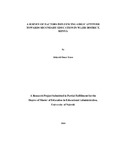| dc.description.abstract | The aim of this study was to investigate the factors influencing girls' attitude towards secondary education in Wajir District. The research objectives included
establishing how availability of learning facilities at schools influence girls'
attitude towards secondary education in Wajir District; how girls relationship with
teachers influence their attitude towards secondary education in Wajir District as
well as determining how economic status of a family influence girls' attitude
towards secondary education in Wajir District. The study also sought to establish
the relationship between parents' level of education and girls' attitude towards
secondary education in Wajir District. The study employed descriptive survey
research design utilizing both quantitative and qualitative approaches where the
target population included all the 5 girls' secondary schools with a population of
1120 girls in Wajir district 5 principals and 33 class teachers totalling to 1158
people. A sample of 25 percent students, 5 guidance and counselling teachers, 28
class teachers and the 5 principals yielding a total of 318 respondents. Each girls
name in attendance register was written on a piece of paper, folded and put in a basket. One girl was blind-folded and asked to pick the folded papers. The papers
were then unfolded and the girls whose names appeared on the papers participated
in the study
Questionnaires were used for data collection. There were four different sets
of questionnaires for the study. These were questionnaires for the principal,
guidance and counseling teachers, class teachers and students. For the
questionnaires were piloted in Moyale girls' secondary school and Sololo Girls
Secondary School in the neighboring Moyale District which had similar
characteristics with Wajir district. The questionnaires were administered to 10
students from each school who were randomly selected, the principal and the
guidance and counseling teacher and class teacher. The results of the piloting were
used to adjust any ambiguity in the questionnaires.
Once the questionnaires were collected, the researcher embarked on the
data analysis. Qualitative and quantitative analysis of data was applied. The
analysis of data was guided by the objectives of the study. Qualitative data were
put and categorized according to themes and where applicable presented in the
form of frequency tables. Quantitative data was analyzed using descriptive statistic
such as percentages means, graphs and charts and the coded data was used to
present information facilitated by Statistical Package for Social Sciences (SPSS).
Findings of the study: From the study, inadequate teaching materials in
schools, and girls 'illicit relationships with teachers as well as poverty in families
negatively affect girls' attitude towards secondary education. In addition, the
majority of students' parents do not have formal education regardless of their
gender. Their illiteracy was however found to negatively affecting girls' attitude
towards secondary education. The researcher therefore recommends that,
government should ensure adequacy of teaching materials in schools to lessen
hardships encountered by students when learning. Girls' illicit relationships with
teachers should also be curbed through appropriate punitive measures while both
teachers and parents should take up the role of educating students with mentality that, there are no readily available jobs and therefore negative attitude on secondary education. Poverty eradication should be enhanced by the government through effective adoption of relevant policies. | en |

